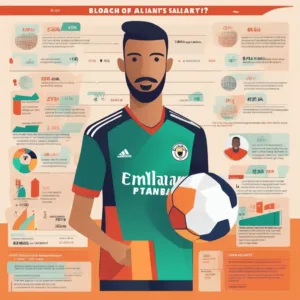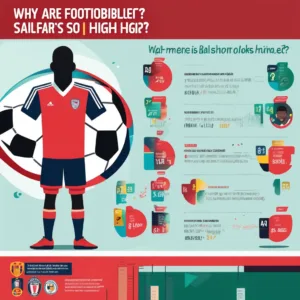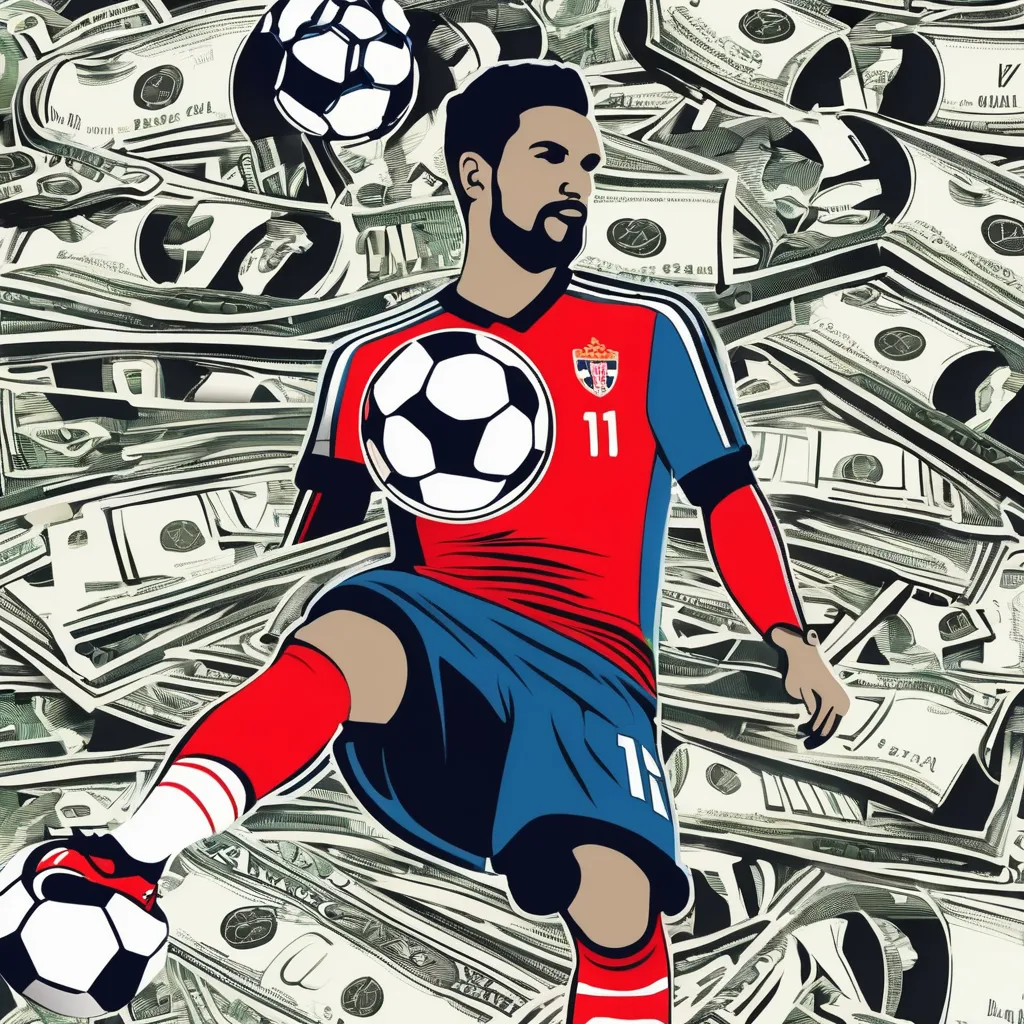Why Are Footballers’ Salaries So High?
The salaries of professional footballers have been a subject of intense debate and fascination for decades. As the global popularity of football continues to soar, so too does the financial compensation of its top athletes. This article delves into the multifaceted economic dynamics that contribute to the high salaries of footballers, examining factors such as media rights, sponsorship deals, global popularity, transfer fees, and more.
The Economic Dynamics Behind Footballers’ Salaries
The economic landscape of professional football is complex and multifaceted, driven by numerous factors that collectively contribute to the high salaries of footballers. At its core, the economics of football are influenced by supply and demand dynamics, where the limited supply of elite talent meets the high demand from clubs, fans, and sponsors. This scarcity of top-tier talent creates a competitive market where clubs are willing to pay premium wages to attract and retain the best players.
Moreover, the globalization of football has expanded the market, allowing clubs to tap into international revenue streams. Broadcasting rights, sponsorship deals, and merchandising have all seen exponential growth, further inflating the financial capabilities of clubs. The influx of capital from wealthy investors and conglomerates has also played a significant role in driving up player salaries.
In addition, the economic impact of football on local and national economies cannot be understated. Football clubs contribute significantly to job creation, tourism, and infrastructure development, which in turn justifies the high salaries of players who are seen as essential assets in this economic ecosystem.
The Role of Media Rights in Footballer Compensation
Media rights have become one of the most lucrative revenue streams for football clubs, significantly impacting player salaries. The sale of broadcasting rights to television networks and streaming platforms generates billions of dollars in revenue, which is often distributed among clubs based on their performance and marketability.
The competition among broadcasters to secure exclusive rights to broadcast major football leagues and tournaments has driven up the value of these deals. This influx of cash allows clubs to offer higher wages to attract top talent, as they can afford to invest more in player salaries without jeopardizing their financial stability.
Furthermore, the global reach of media rights deals means that football matches are accessible to a worldwide audience, increasing the sport’s popularity and, consequently, the market value of its players. As a result, footballers benefit from the financial windfall generated by media rights, with a significant portion of this revenue being allocated to player compensation.
Sponsorship Deals and Their Impact on Player Earnings
Sponsorship deals play a crucial role in augmenting footballers’ earnings, both directly and indirectly. Major corporations are eager to associate their brands with high-profile athletes, offering lucrative endorsement deals that can significantly boost a player’s income.
These sponsorship deals are often performance-based, incentivizing players to maintain high levels of performance and marketability. The endorsement income can sometimes surpass a player’s club salary, making it a vital component of their overall earnings.
Moreover, the presence of high-profile sponsors enhances the financial stability of football clubs, allowing them to offer competitive salaries to attract and retain top talent. The symbiotic relationship between players and sponsors creates a mutually beneficial ecosystem where both parties thrive financially.
The Influence of Global Popularity on Footballer Salaries
The global popularity of football is a fundamental driver of high player salaries. Football is the most widely followed sport in the world, with an estimated 4 billion fans globally. This immense fan base translates into substantial revenue streams for clubs, including ticket sales, merchandise, and broadcasting rights.
The international appeal of football means that clubs can tap into diverse markets and generate income from various regions. This global reach enhances the financial capabilities of clubs, enabling them to offer higher wages to attract top talent.
Additionally, the popularity of football creates a competitive environment where clubs vie for the best players to enhance their performance and marketability. This competition drives up player salaries as clubs are willing to pay a premium to secure the services of elite athletes who can attract fans and sponsors.
Transfer Fees and Their Effect on Player Wages
Transfer fees are a significant factor in the financial landscape of football, directly impacting player wages. When a club acquires a player from another club, they often pay a substantial transfer fee to secure their services. These fees can reach astronomical figures, especially for top-tier talent.
The high transfer fees reflect the market value of players and their potential impact on a club’s performance and revenue. Clubs are willing to invest heavily in acquiring top talent, as a successful player can drive ticket sales, merchandise, and sponsorship deals.
Furthermore, the payment of substantial transfer fees often leads to higher wages for players. Clubs are motivated to offer competitive salaries to justify their investment and ensure that the player remains committed and motivated. As a result, transfer fees and player wages are closely intertwined, with each influencing the other.

The Financial Power of Football Clubs
Football clubs wield significant financial power, enabling them to offer high salaries to attract and retain top talent. The financial capabilities of clubs are influenced by various revenue streams, including ticket sales, broadcasting rights, sponsorship deals, and merchandise.
Wealthy club owners and investors also play a crucial role in enhancing the financial power of football clubs. These individuals and conglomerates inject substantial capital into clubs, allowing them to invest in top-tier talent and infrastructure. The financial backing of wealthy owners provides clubs with the resources needed to offer competitive salaries and remain financially stable.
Moreover, the financial power of football clubs is often reflected in their ability to compete in international competitions and secure lucrative broadcasting and sponsorship deals. The success of clubs on the field translates into financial success off the field, creating a cycle where high performance leads to increased revenue and higher player salaries.
Market Demand and Its Role in Determining Salaries
Market demand is a fundamental factor in determining footballers’ salaries. The limited supply of elite talent and the high demand from clubs, fans, and sponsors create a competitive market where players command premium wages.
The market demand for top-tier talent is influenced by various factors, including a player’s performance, marketability, and potential impact on a club’s success. Clubs are willing to pay high salaries to secure the services of players who can enhance their performance and attract fans and sponsors.
Additionally, market demand is influenced by the economic landscape of football, including broadcasting rights, sponsorship deals, and merchandising. The financial capabilities of clubs and the revenue generated from various sources create a market where high salaries are justified and sustainable.
The Impact of Merchandising on Footballer Earnings
Merchandising is a significant revenue stream for football clubs, directly impacting player earnings. The sale of jerseys, apparel, and other merchandise generates substantial income for clubs, which can be used to offer competitive salaries to attract and retain top talent.
High-profile players often drive merchandise sales, as fans are eager to purchase items associated with their favorite athletes. The marketability of players enhances their value to clubs, leading to higher wages and endorsement deals.
Moreover, merchandising revenue contributes to the financial stability of clubs, allowing them to invest in top-tier talent and infrastructure. The symbiotic relationship between players and merchandising creates a mutually beneficial ecosystem where both parties thrive financially.
The Relationship Between Performance and Pay
The relationship between performance and pay is a crucial factor in determining footballers’ salaries. Clubs are motivated to offer competitive wages to players who consistently deliver high levels of performance and contribute to the team’s success.
Performance-based incentives are often included in player contracts, rewarding athletes for achieving specific milestones, such as goals scored, assists, and appearances. These incentives create a direct link between a player’s performance and their earnings, motivating them to maintain high levels of performance.
Additionally, the performance of players directly impacts a club’s revenue streams, including ticket sales, broadcasting rights, and sponsorship deals. Successful players enhance the marketability of the club, attracting fans and sponsors and justifying higher salaries.

The Role of Agents in Negotiating Salaries
Agents play a crucial role in negotiating salaries and securing lucrative contracts for footballers. These professionals represent players in contract negotiations, leveraging their expertise and industry knowledge to secure the best possible deals.
Agents are motivated to secure high salaries for their clients, as their earnings are often based on a percentage of the player’s income. This creates an incentive for agents to negotiate aggressively and secure lucrative contracts that reflect the market value of their clients.
Moreover, agents often have extensive networks and relationships within the football industry, allowing them to identify opportunities and negotiate favorable terms for their clients. The role of agents in negotiating salaries is a critical factor in the financial landscape of professional football.
The Influence of Social Media on Player Marketability
Social media has become a powerful tool in enhancing the marketability of footballers, directly impacting their earnings. Platforms such as Instagram, Twitter, and Facebook allow players to connect with fans, build their personal brand, and attract sponsorship deals.
The ability to reach a global audience through social media enhances a player’s marketability, making them more attractive to sponsors and clubs. High-profile players with substantial social media followings often command higher salaries and endorsement deals due to their influence and reach.
Additionally, social media provides a platform for players to showcase their personality, interests, and off-field activities, further enhancing their marketability. The influence of social media on player marketability is a significant factor in the financial landscape of professional football.
Television Contracts and Revenue Distribution
Television contracts are a major source of revenue for football clubs, significantly impacting player salaries. The sale of broadcasting rights to television networks generates billions of dollars in revenue, which is often distributed among clubs based on their performance and marketability.
The competition among broadcasters to secure exclusive rights to broadcast major football leagues and tournaments has driven up the value of these deals. This influx of cash allows clubs to offer higher wages to attract top talent, as they can afford to invest more in player salaries without jeopardizing their financial stability.
Moreover, the global reach of television contracts means that football matches are accessible to a worldwide audience, increasing the sport’s popularity and, consequently, the market value of its players. As a result, footballers benefit from the financial windfall generated by television contracts, with a significant portion of this revenue being allocated to player compensation.
The Economic Impact of Football on Local Economies
The economic impact of football on local economies is a significant factor in justifying high player salaries. Football clubs contribute to job creation, tourism, and infrastructure development, generating substantial economic benefits for local communities.
The presence of a successful football club can attract tourists, boost local businesses, and create employment opportunities. The economic benefits of football extend beyond the club itself, positively impacting the broader community.
Moreover, the financial success of football clubs allows them to invest in local infrastructure, including stadiums, training facilities, and community programs. The economic impact of football on local economies creates a justification for high player salaries, as players are seen as essential assets in this economic ecosystem.
The Role of International Competitions in Salary Inflation
International competitions play a crucial role in driving up player salaries, as they provide a platform for players to showcase their talent on a global stage. Tournaments such as the FIFA World Cup, UEFA Champions League, and Copa America attract worldwide audiences and generate substantial revenue for clubs and players.
The success of players in international competitions enhances their marketability and increases their value to clubs. Players who perform well on the international stage often command higher salaries and transfer fees, as clubs are eager to secure the services of top-tier talent.
Moreover, international competitions drive up the value of broadcasting rights and sponsorship deals, further inflating player salaries. The role of international competitions in salary inflation is a significant factor in the financial landscape of professional football.
Comparative Analysis of Salaries in Different Leagues
The salaries of footballers vary significantly across different leagues, influenced by factors such as revenue streams, market demand, and financial capabilities of clubs. Major leagues such as the English Premier League, La Liga, and Serie A offer some of the highest salaries in professional football, driven by substantial broadcasting rights, sponsorship deals, and merchandising revenue.
In contrast, smaller leagues and lower divisions often offer lower salaries, reflecting the limited financial capabilities of clubs. The disparity in salaries across different leagues highlights the economic dynamics of professional football, where the financial success of clubs is directly linked to their ability to offer competitive wages.
Moreover, the comparative analysis of salaries in different leagues provides insights into the global landscape of professional football, highlighting the factors that contribute to the high salaries of top-tier players.
The Effect of Club Ownership Models on Player Pay
The ownership models of football clubs play a crucial role in determining player salaries. Clubs owned by wealthy individuals, conglomerates, or state entities often have substantial financial resources, allowing them to offer high wages to attract and retain top talent.
In contrast, clubs with limited financial backing or community ownership models may struggle to compete in the market for elite talent, resulting in lower salaries. The financial capabilities of club owners directly impact the club’s ability to invest in top-tier talent and infrastructure.
Moreover, the ownership models of football clubs influence their financial stability and long-term sustainability. Clubs with wealthy owners are often able to weather economic downturns and invest in long-term success, further justifying the high salaries of their players.
Historical Trends in Footballer Compensation
The historical trends in footballer compensation provide valuable insights into the evolution of player salaries over time. The salaries of footballers have seen exponential growth over the past few decades, driven by factors such as the globalization of the sport, the influx of capital from wealthy investors, and the increasing value of broadcasting rights and sponsorship deals.
The historical trends in footballer compensation highlight the changing dynamics of the sport, where the financial success of clubs and the market value of players have seen significant growth. The evolution of player salaries reflects the broader economic landscape of professional football, where high salaries are justified by the substantial revenue generated by the sport.
Moreover, the historical trends in footballer compensation provide a context for understanding the current financial landscape of professional football, highlighting the factors that contribute to the high salaries of top-tier players.
The Role of Collective Bargaining Agreements
Collective bargaining agreements (CBAs) play a crucial role in determining player salaries and working conditions in professional football. These agreements are negotiated between players’ unions and league authorities, setting the terms and conditions of employment for players.
CBAs often include provisions related to minimum salaries, performance-based incentives, and revenue sharing, ensuring that players receive fair compensation for their contributions. The role of collective bargaining agreements in professional football is a significant factor in the financial landscape of the sport, as they provide a framework for negotiating player salaries and working conditions.
Moreover, CBAs contribute to the overall stability and sustainability of professional football, ensuring that players are fairly compensated and that clubs can operate within a financially viable framework. The role of collective bargaining agreements in determining player salaries is a critical factor in the financial landscape of professional football.

The Impact of Economic Recessions on Football Salaries
Economic recessions can have a significant impact on football salaries, as clubs may face financial challenges and reduced revenue streams. During economic downturns, clubs may struggle to generate income from ticket sales, broadcasting rights, and sponsorship deals, leading to financial constraints.
The impact of economic recessions on football salaries can result in wage reductions, deferred payments, and reduced transfer activity. Clubs may be forced to implement cost-cutting measures to remain financially viable, affecting player salaries and contract negotiations.
Moreover, economic recessions can influence the broader financial landscape of professional football, impacting the market value of players and the financial capabilities of clubs. The impact of economic recessions on football salaries highlights the vulnerability of the sport to external economic factors and the need for financial sustainability.
Future Projections for Footballer Earnings
The future projections for footballer earnings suggest continued growth, driven by factors such as the globalization of the sport, the increasing value of broadcasting rights and sponsorship deals, and the financial capabilities of clubs. The market demand for top-tier talent is expected to remain high, further driving up player salaries.
Moreover, the influence of technology and social media on player marketability is likely to enhance the earning potential of footballers, as players can leverage their online presence to attract sponsorship deals and build their personal brand.
However, the future projections for footballer earnings also highlight the need for financial sustainability and responsible management within the sport. The continued growth of player salaries must be balanced with the financial stability of clubs and the broader economic landscape of professional football.
In conclusion, the high salaries of footballers are the result of a complex interplay of economic dynamics, including media rights, sponsorship deals, global popularity, transfer fees, and more. The financial landscape of professional football is influenced by various factors that collectively contribute to the substantial compensation of its top athletes. As the sport continues to evolve, the factors driving player salaries will likely adapt, reflecting the changing dynamics of the global football industry.







